NRAO Newsletter
Volume Vol#, Issue Iss#
Day# Month# Year#
NRAO Newsletter
Volume Vol#, Issue Iss# • Day# Month# Year#

Subscriber poll - answer this month's question...
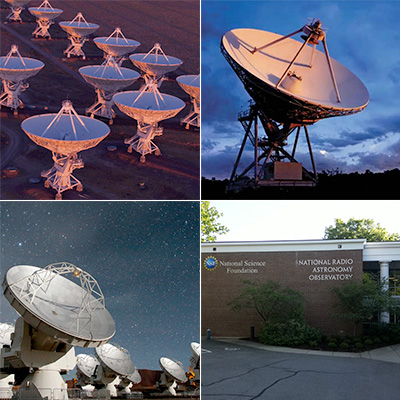
What features of the NRAO Newsletter are most useful?
Upcoming Events

15th DiFX Users and Developers Meeting
September 11 - 15, 2023 | Socorro, NM

First Mexican ngVLA Meeting
September 25 - 27, 2023 | Morelia, Mexico

NRAO Community Days at IRyA-UNAM
September 28 - 29, 2023 | Morelia, Mexico

mtex-ngVLA Event
September 28, 2023 | Leipzig, Germany

Cycle 10 ALMA Events Data Processing Workshops
Sept - Oct, 2023 | Various Locations

ALMA Data Reduction Party: Data Combination
November 6-8, 2023 | Charlottesville, VA
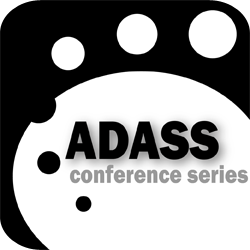
Astronomical Data Analysis Software and Systems XXXIII
November 4 - 9, 2023 | Tucson, Arizona

ALMA at 10 years: Past, Present, and Future
December 4 - 8, 2023 | Puerto Varas, Chile
VLBA Celebrates 30 Years of Science
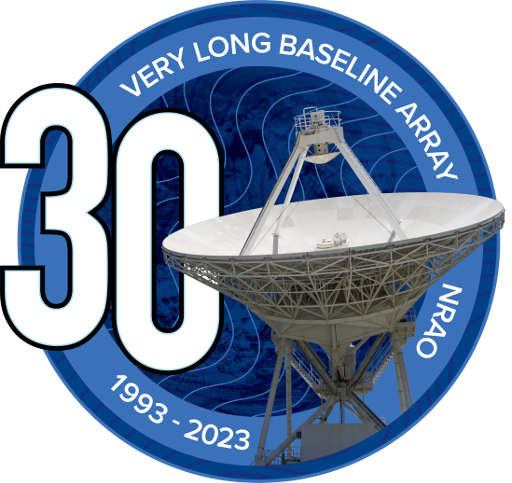
Jeff Hellerman (NRAO/AUI/NSF)
The VLBA has reached a milestone - 30 years of operation with cutting edge science observations using high-resolution interferometry. The ten VLBA radio telescopes, along with the high-sensitivity array (HSA), have transformed many areas of modern astrophysics. Read Brian Koberlein's article all about the St. Croix VLBA station with photography by Jeff Hellerman. The NRAO and United States Naval Observatory (USNO) issued a press release commemorating this 30 year achievement.
Call for VLASS Epoch 4 Scientific Input
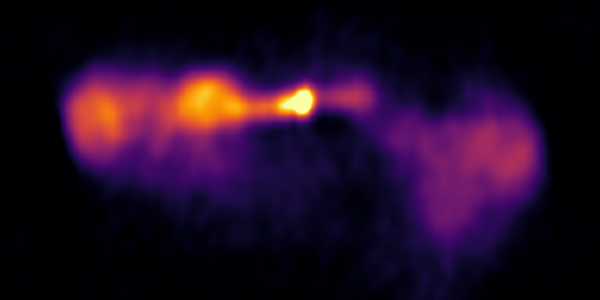
VLA Sky Survey (NRAO/AUI/NSF)
The VLA Sky Survey (VLASS) is an ongoing VLA all-sky survey at 2-4 GHz (10cm/S-band). The resolution of 2.5 arcseconds, depth of ~90 microJy, spectral index and polarization mapping of the entire sky are unique features of VLASS and the data are complementary to other ongoing and future sky surveys across the electromagnetic spectrum. VLASS is designed to observe the sky in three separate epochs, which opens up the exciting field of time variability and transient science. Raw and calibrated VLASS data, as well as quick look images are readily available and the VLASS team are starting to deliver more refined data products. Data, status, and timeline of VLASS are available at the VLASS webpage.
An exciting possibility for a VLASS expansion is a potential fourth epoch. An additional epoch of observation will extend VLASS into the era of the Vera Rubin Observatory's Legacy Survey of Space and Time (LSST), adding a fourth sky coverage for significant improvements in transient detection and monitoring as well as resulting in a slightly deeper combined image. At this point we would like to receive feedback from the community on the scientific impact of a fourth epoch on specific research areas, including new scientific opportunities that could be opened up by VLASS either by continuing the current survey strategy into a fourth epoch, or adopting a different one that would still allow long-term studies of transient and variable sources. Of particular interest would be the choice of cadence between the third and a potential fourth epoch. Current VLASS coverages are 32 months apart, increasing the cadence by 1-2 configuration cycles will allow the gap in cadence between the prior FIRST/NVSS surveys and VLASS to be filled in. The VLASS Survey Science Group (SSG) plans to submit a proposal for this VLASS extension by the end of 2023 for review by the NRAO director. All input should be directed to the VLASS department of the NRAO helpdesk.
Call for Applications - Jansky Postdoctoral Fellowship
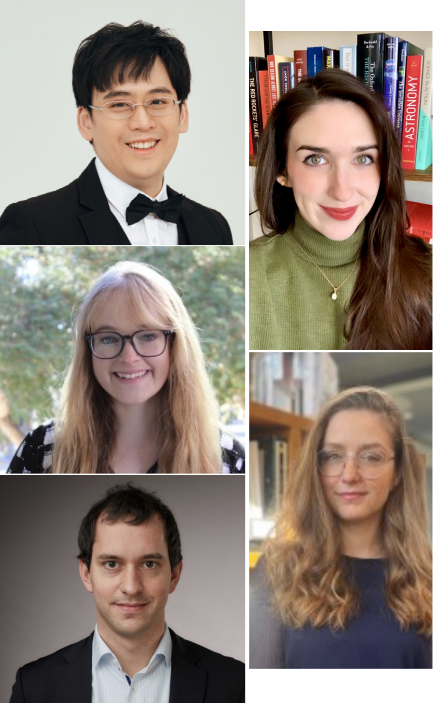
The talented group of Jansky Postdoctoral Fellows are leaders in their respective fields of science and engineering research.
The National Radio Astronomy Observatory (NRAO) is inviting applications for the 2024 Jansky Fellowship Program! The program was established in the 1980s, and for almost four decades has been attracting exceptional researchers that moved on to eminent careers in radio astronomy and beyond. The Jansky Fellowship supports outstanding early career scientists to conduct independent research that is broadly related to the NRAO’s mission. We welcome applicants who bring diverse and innovative dimensions to the Observatory and to the field of radio astronomy. Jansky Fellows spend most, if not all of their time on self-directed independent research within the NRAO scientific and research environment. As a Jansky Fellow, you will also have a unique opportunity to contribute to and learn from the development and delivery of the largest and most capable radio telescopes in the world. Candidates with interests in radio astronomy science and techniques, multi-wavelength collaborations, instrumentation, computation, and theory are encouraged to apply.
The submission deadline for the 2024 Jansky Fellowship Program application is Wednesday, November 1, 2023 for the fellowship appointment starting nominally in September 2024. For details on the 2024 Jansky Fellowship Program and on how to apply see our application submission portal.
ALMA Ambassadors Program for Cycle 11
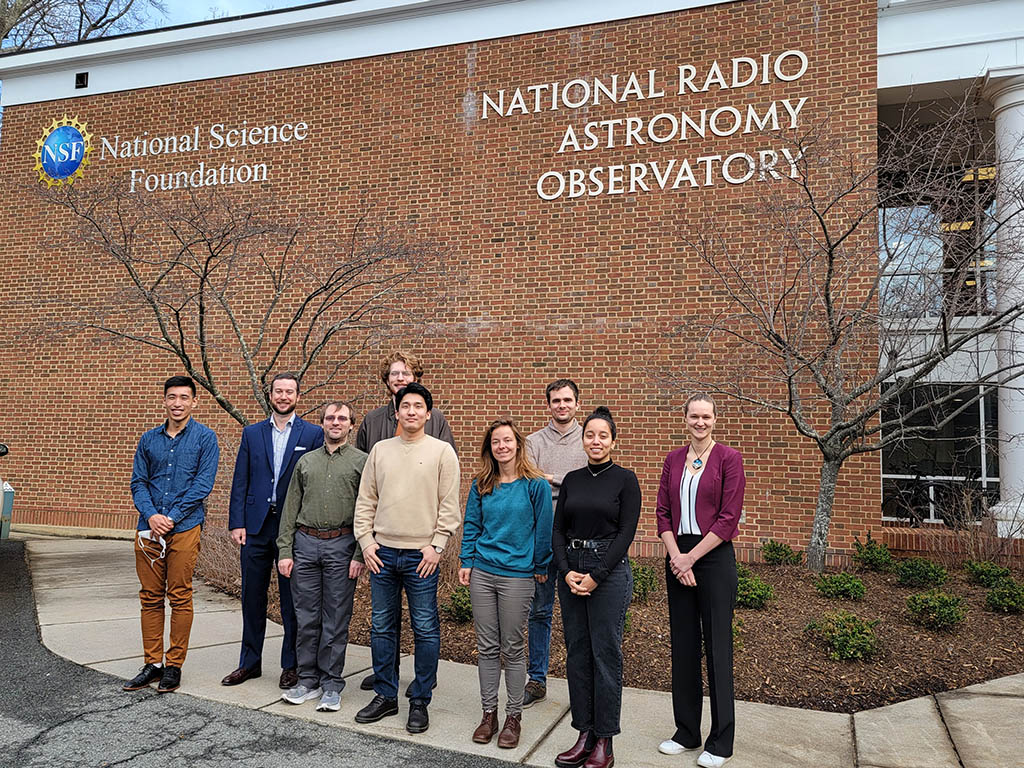
George Privon (NRAO/NAASC/AUI/NSF)
[click to enlarge]
Members of the Cycle 10 ALMA Ambassador cohort visited the NRAO Headquarters and the NAASC in Charlottesville, VA for training in February 2023.
The North American ALMA Science Center (NAASC) is accepting applications for the ALMA Ambassadors Program, with a deadline of October 13, 2023. The program provides training and up to a $10,000 USD research grant (other forms of payment are available, see below) to postdoctoral researchers, senior graduate students, and early career researchers interested in expanding their ALMA/radio interferometry expertise and sharing that knowledge with their home (or other) institutions. For Cycle 11, ALMA Ambassadors can choose to support the community by organizing and hosting either (1) ALMA Cycle 11 proposal preparation support workshops, or (2) ALMA-focused data processing and analysis workshops.
The NAASC will provide travel support for the training as well as all talk materials, supplies, and infrastructure for the workshops hosted by the ALMA Ambassadors. Some radio or submillimeter interferometry experience is preferred but not required. Applicants must be based at a North American institution. If you do not meet these requirements but are interested in learning more about the training we are offering, please contact George Privon to discuss opportunities. We will consider both individual and coordinated applications from users in the same institution or region.
The NAASC will host the selected Ambassadors at the National Radio Astronomy Observatory headquarters in Charlottesville, Virginia the week of February 12, 2024 to receive in-depth training. Training will include topics related to ALMA proposal writing, including: interferometry basics, ALMA science capabilities, recent ALMA headlines, use of the ALMA Observing Tool, and guidance for speaking on these topics. The training also includes a poster session where ALMA Ambassadors will showcase their own science to their fellow ambassadors and the local astronomical community, including NRAO staff. Ambassadors must host a proposal preparation workshop in advance of the Cycle 11 ALMA proposal deadline in April 2024 or data analysis and processing workshops. These workshops may be held at the ambassador's home institute, an alternate location, or virtually. ALMA Ambassadors will also make themselves available to help their local community between the call for proposals and the deadline and support other NAASC activities.
We particularly encourage applications from those interested in the data processing and analysis workshops or in targeting specific scientific communities (e.g., stellar astrophysics).
The deadline to apply is October 13, 2023. For more information, please visit the ALMA Ambassadors website.
ALMA Data Processing/Analysis Workshops for Cycle 10
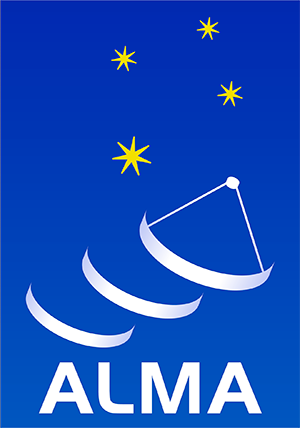
The North American ALMA Science Center (NAASC) and the Cycle 10 ALMA Ambassadors have organized a series of workshops on the processing and analysis of ALMA data. These workshops will take place in September-October 2023. The goal of these events is to train users on basic data processing and analysis techniques that they may need to use ALMA for scientific discovery. Topics may include:
- Imaging/cleaning of continuum and spectral line observations
- Self-calibration
- Imaging of data from multiple array configurations
- Using the Pipeline Weblog and Re-running the Imaging Pipeline
- Using CARTA for Image Visualization and Analysis
- Science-ready Data Products
- What's New in CASA (Common Astronomy Software Applications)
- The ALMA Press Release Process
Information on the locations and dates for these workshops is available on the NAASC Community Events webpage and in the table below. Early registration is encouraged to facilitate tailoring the workshops to the interests of the attendees.
| Ambassador | Workshop Location | Date |
|---|---|---|
| Adam Dong | Univ. of British Columbia | September 13, 2023 |
| Emily Moravec | West Virginia University | October 5, 2023 |
| Dylan Paré | Villanova University | October 16, 2023 |
| Johnathan Stauffer | National Solar Observatory* | October 19-20, 2023 |
| Marion Villenave | Jet Propulsion Lab | October 23-24, 2023 |
ALMA Data Reduction Party: Data Combination
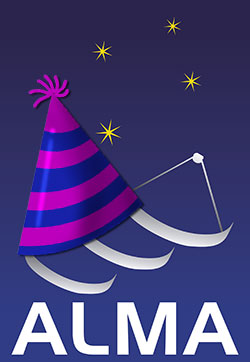
The North American ALMA Science Center (NAASC) is pleased to announce an ALMA Data Reduction Party on Data Combination that will take place November 6-8, 2023 at the North American ALMA Science Center in Charlottesville, Virginia. During this 3-day event, NAASC scientists and data analysts will provide focused information and individualized support to a cohort of North American PI or Archival ALMA users who want support to image ALMA data from multiple arrays that include 7-m and/or Total Power observations. To facilitate data processing, attendees will be provided access to NRAO computing resources both during and after the workshop; the event is fully in-person, and travel support can be provided upon request. Attendees will be encouraged to define their individual objectives ahead of the event and can expect outcomes such as:
- Understanding the importance of short spacings (compact configurations or single dish) for interferometric imaging with ALMA data
- Obtaining an image for at least a subset (i.e. spectral window, channel range, or portion of the image) of their dataset
- Developing a recipe for image combination techniques they can apply to their dataset
- Quantitative assessment of imaging quality before and after adding short spacing information.
Attendance is limited to 10 researchers based at institutions in North America. Applicants should have experience with general interferometric imaging, have their data in hand at the time of the application deadline, and be prepared to join an online preparation session prior to the event. If you are interested in this opportunity, please fill out this application form by the deadline of September 25 at 15:00 ET. We will select applicants based on the complexity of their projects and scientific goals. Applicants who do not get selected for this event may instead be invited for an individual face-to-face visit.
Paul Vanden Bout named 2023 Jansky Lecturer
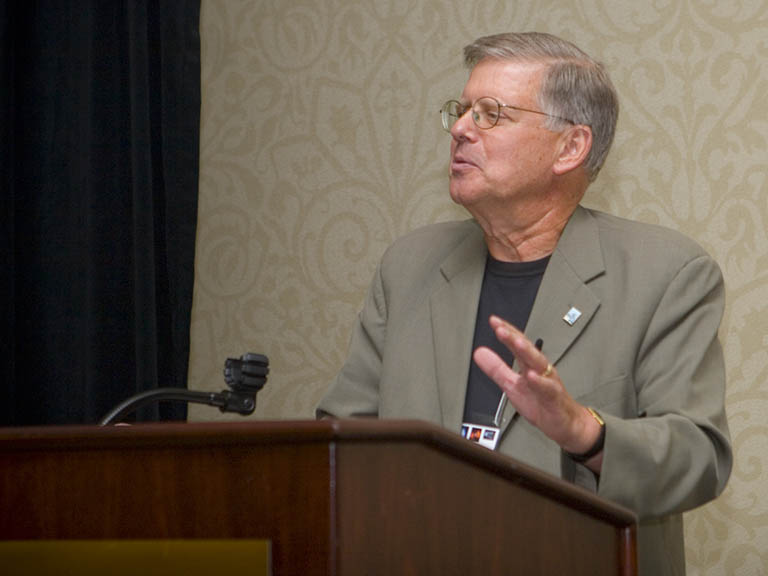
NRAO Archives (NRAO/AUI/NSF)
The NRAO is pleased to award the 2023 Karl G. Jansky Lectureship to Dr. Paul Vanden Bout, Senior Scientist, Emeritus at the National Radio Astronomy Observatory. The Jansky Lectureship is an honor established by the trustees of AUI to recognize and celebrate outstanding contributions to the advancement of radio astronomy.
During his tenure as NRAO Director from 1985 to 2002, a pivotal moment arose when the Subcommittee on Millimeter- and Submillimeter-Wavelength Astronomy, chaired by Alan Barrett, highlighted the necessity for a large millimeter array. Dr. Vanden Bout played a crucial role in turning this idea into reality, culminating in the creation of ALMA (Atacama Large Millimeter/submillimeter Array). His leadership was instrumental in forming the ALMA partnership, and he successfully secured funding for the construction of ALMA even before stepping down from his Director position. His vision and efforts have significantly contributed to the radio astronomy landscape in the United States today not just with ALMA but also with the construction of both the VLBA and the GBT and the planning for and initiation of the EVLA project.
After earning his A.B. degree from Calvin College in 1961 and his Ph.D. from the University of California, Berkeley, in 1966, he has remained deeply engaged in scientific pursuits, with a particular focus on interstellar molecular spectroscopy. His primary interest lies in using molecular spectroscopy, especially at millimeter wavelengths, to deduce the physical characteristics of star-forming interstellar clouds. Throughout his career, he has actively served on various committees, showcasing his commitment to advancing scientific research. Some of the notable committees he has been a part of include the LIGO Program Advisory Committee, the NAS Committee on Radio Frequencies, and the NSF Astronomy Advisory Committee. He has also been involved with the American Astronomical Society (AAS) Council, served on several AAS committees, and held the position of AAS vice-president from 2005 to 2008.
His dedication to the field of astronomy extended to being a member of the Committee for a Decadal Survey of Astronomy and Astrophysics for the 2010-2020 decade, contributing his expertise to shape the direction of research in the field during that period. Dr. Vanden Bout has also published a new book with co-authors Bob Dickman and Adele Plunkett, titled The ALMA Telescope: The Story of a Science Mega-Project, and tells the history of the ALMA Project from its earliest beginnings to its inauguration and first decade of science. The book is available in both print and ebook formats from Amazon or Barnes and Noble. The print version can also be ordered direct from Cambridge University Press. It can also be downloaded free as an Open Access book using the same URL.
The lectures will take place on the following dates:
- Charlottesville on Wednesday, November 8, 2023. There will be a reception starting at 6PM at Darden with the lecture starting at 7PM ET.
- Green Bank on Thursday, November 9, 2023. The lecture will take place in the Science Center auditorium starting at 7PM ET followed by a dinner with the Green Bank staff.
- Socorro on Friday, November 17, 2023. The lecture will follow the NM Symposium and start at 7PM at the Macey Center followed by a reception.
ngVLA Project News
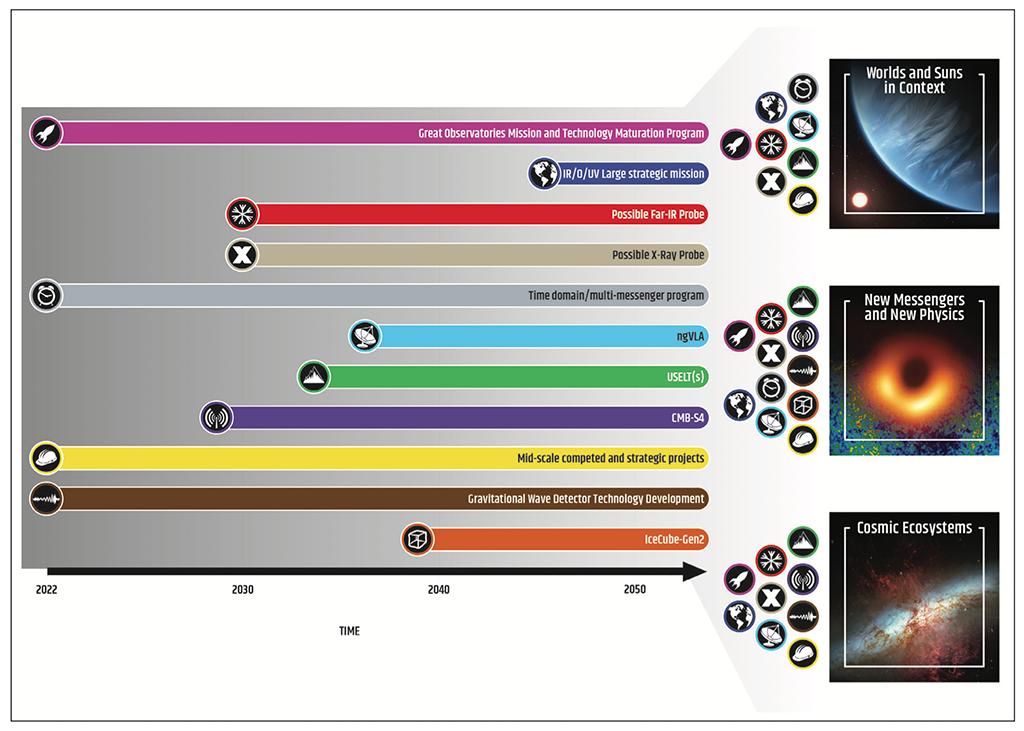
National Academy of Sciences
[click to enlarge]
Programs & projects recommended by Astro2020.
ngVLA Enters the MREFC Review Process
In July the U.S. National Science Foundation approved the ngVLA project for entry into the Major Research Equipment & Facilities Construction (MREFC) review process. MREFC queue entry is not a commitment to construct the ngVLA, but does signal strong scientific and technical promise, and growing project readiness. Three MREFC reviews (Conceptual, Preliminary, Final) will be completed over the next three or so years. Those reviews will provide the Foundation with the critical information needed to consider adding ngVLA construction to a budget request later this decade.
That the ngVLA has entered the MREFC queue is a testament to the community's strong support for the project. We are very grateful for that support!
Special Session: Space Weather on Other Worlds
The NRAO and the ngVLA project will convene a Special Session titled "Space Weather on Other Worlds" in January 2024 at the American Astronomical Society meeting in New Orleans, LA.
The session will highlight recent scientific breakthroughs in characterizing space weather on other worlds with current facilities; describe planned near- and long-term improvements for ground- and space-based facilities; discuss major scientific leaps likely to result from next-generation facilities across the electromagnetic spectrum; and review the highest-priority themes in this area for the state-of-the-art observatories to be commissioned in the next decade.
Invited presentations by Bin Chen (NJIT), Lia Corrales (University of Michigan), Cynthia Froning (Southwest Research Institute), Melodie Kao (University of California, Santa Cruz), Sebastian Pineda (University of Colorado), and Jackie Villadsen (Bucknell College) will be featured. Contributed iPoster presentations are welcomed. Abstracts are due September 29.
ngVLA Science - Strong Gravitational Lensing as a Probe of Dark Matter
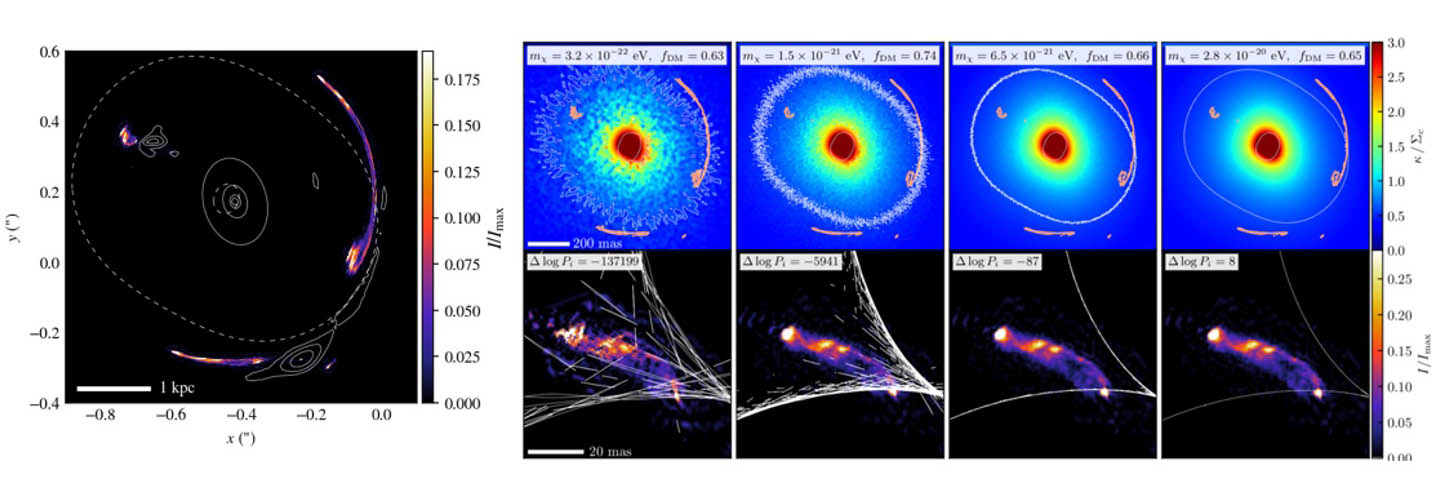
[click to enlarge]
Gravitational lens system MG J0751+2716. Left - VLBI observations at 1.6 GHz (Powell et al. 2022). Right - Model lensed images (top) and reconstructed source surface brightness maps (bottom) for some realizations in a fuzzy DM cosmology (Powell et al. 2023).
Dark matter (DM) comprises about 85% of the total mass of the Universe. The nature of DM is unknown. In the prevailing cosmology paradigm, DM is assumed to be cold and collisionless. This paradigm successfully describes the Universe on large scales. But it is mostly untested on galactic and sub-galactic scales, where alternative models such as warm, self, and fuzzy DM produce markedly different distributions (reviewed by Bertone & Tait 2018).
In strong gravitational lensing, light from a distant galaxy passes by another galaxy, and multiple highly-magnified and distorted images of the distant galaxy are observed. Lensing's sensitivity to all matter between the observer and the distant galaxy provides a clean method to measure the DM distributions on sub-galactic scales. Lensing constraints from a spatially resolved source depend heavily on angular resolution, with most DM imprints occuring on scales of a few milliarcseconds. For this reason, Very Long Baseline Interferometry (VLBI) is a key tool to constrain DM properties on sub-galactic scales (reviewed by Vegetti et al. 2023).
A few hundred strong lenses are known, but only a handful are bright enough for study with today's VLBI arrays (e.g., Spingola et al. 2018, 2019). For one of these lenses, the figure shows its VLBI image and some models for it in a fuzzy DM cosmology (Powell et al. 2022, 2023).
Compared to today's VLBI arrays, the high sensitivity and high resolution of the ngVLA will provide transformational improvements. Also, future wide-field surveys are projected to deliver several hundred thousand more galaxy-galaxy lens systems (e.g., Oguri & Marshall 2010, McKean et al. 2015). Imaging this population with the ngVLA will both strengthen constraints on DM distributions on sub-galactic scales and mitigate the effects of systematic biases (Powell et al. 2022).
Since 2015 the acronym ngVLA has appeared in 1000+ publications indexed in the SAO/NASA Astrophysics Data System. This article continues a regular feature intended to showcase some of those publications. We are especially interested in showcasing work done by early-career researchers. The collection of showcase articles can be viewed online. Anyone wishing to volunteer to author a feature should contact Joan Wrobel.
ALMA Program News
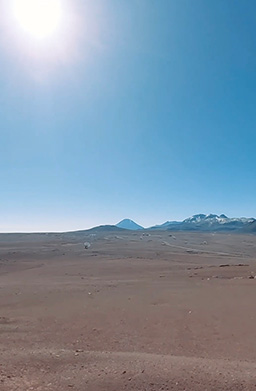
S. Otarola Photography
ALMA Observing Status
ALMA is observing in its current C-9 configuration (baselines 368-13900m; 100GHz beam 0.057") before commencing Cycle 10 on October 1, 2023. Weather has been very good. The just-completed C-10 configuration was successful. Moving 100 ton antennas on the 130 ton transporters to the longest 16km baselines in late winter always poses challenges; all antenna stations were occupied during Cycle 9 for the first time.
ALMA Cycle 10 Call for Proposals status
Cycle 10 Principal Investigators were informed of the status of their Cycle 10 Observing Proposals during the third week of August. ALMA proposals are selected by competitive peer review through either the distributed peer review process or the ALMA Proposal Review Committee (APRC). A PI Survey for the Cycle 10 Main Call was distributed to PIs.
Conference ALMA at 10 years: Past, Present, and Future Dec 4-8, 2023
The conference ALMA at 10 years: Past, Present, and Future will be held in Puerto Varas, Chile, on 4-8 December 2023. The conference covers ALMA's first decade of science operations while looking forward to the evolution of ALMA's capabilities in its second decade. Abstract submission for contributed talks closed on May 31, 2023. 279 abstracts for contributed talks were received!
Although registration for in-person attendance has reached capacity and is closed, registration for on-line participation, including posters, is open until November 2, 2023. Please visit the registration web page to submit a poster abstract for on-line participation.
International Symposium on Space Terahertz Technology Conference
The ISSTT 2024 Organizing Committee is excited to announce that the 33rd International Symposium on Space Terahertz Technology will be held in historic Charlottesville, Virginia, USA, April 7-11, 2024.
In 2024, the Symposium will again focus on millimeter- and submillimeter-wave and Terahertz technologies, and their applications in astronomy, planetary science, Earth science, and general remote sensing. There will be a student paper contest and our special theme in 2024 will be metamaterials and their use.
Deadlines for registration, abstracts, student paper submissions will be announced in the fall. More information can be found on the website.
The city of Charlottesville is home to our meeting hosts, the National Radio Astronomy Observatory and Virginia Diodes as well as University of Virginia. Surrounded by natural beauty, it is the gateway to the Shenandoah National Park.
Advanced Spectrum Monitor Development and the NRDZ
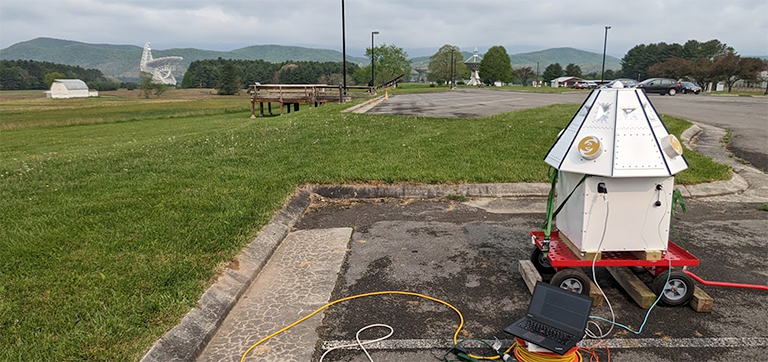
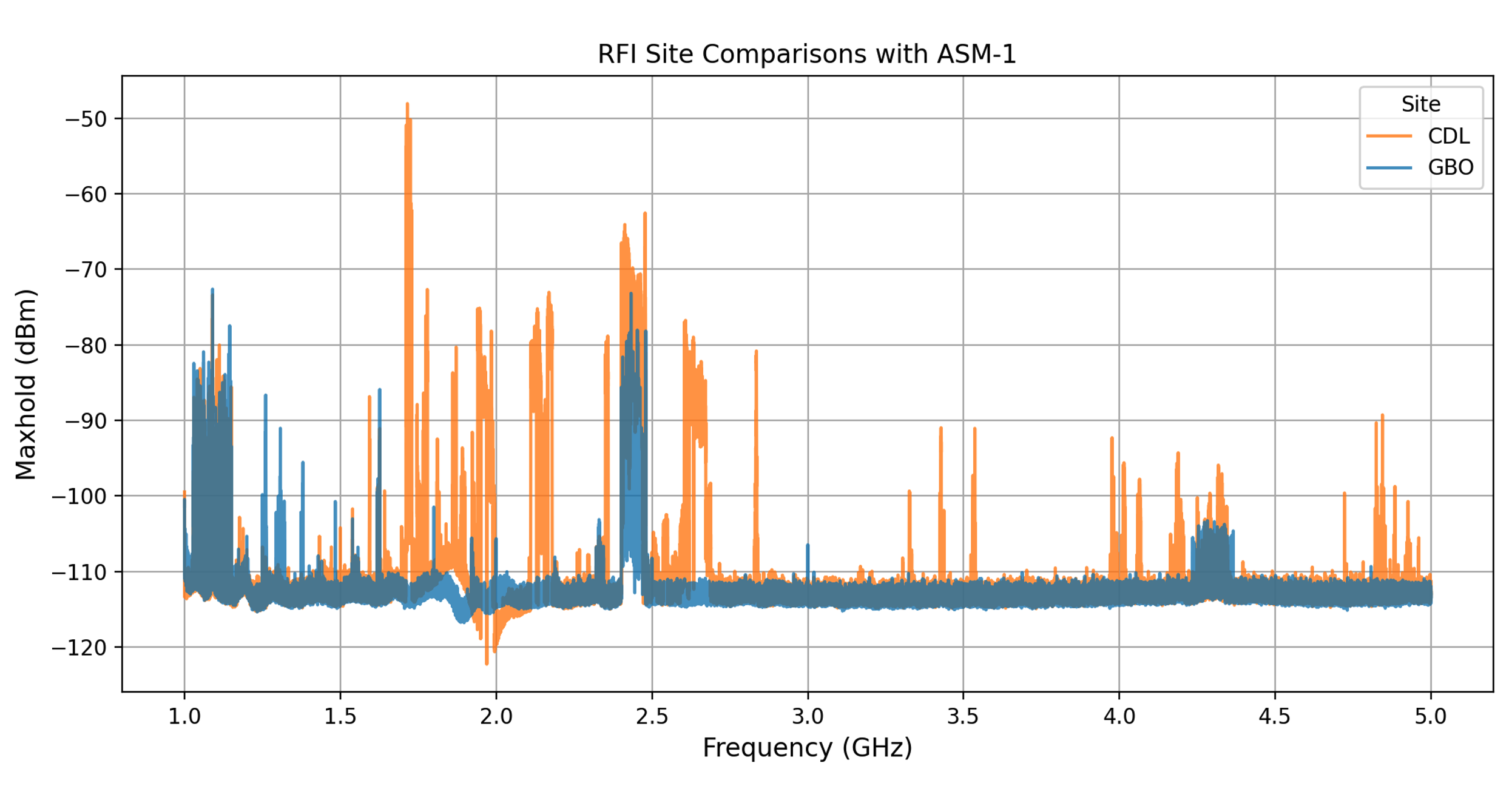
[click to enlarge]
A comparison of the RFI environment at the CDL (Charlottesville) and Green Bank Observatory as measured by the ASM-1 device in May 2023. While the GBO RFI environment is markedly better than CDL, there is still RFI apparent - especially in WIFI bands - in the NRQZ.
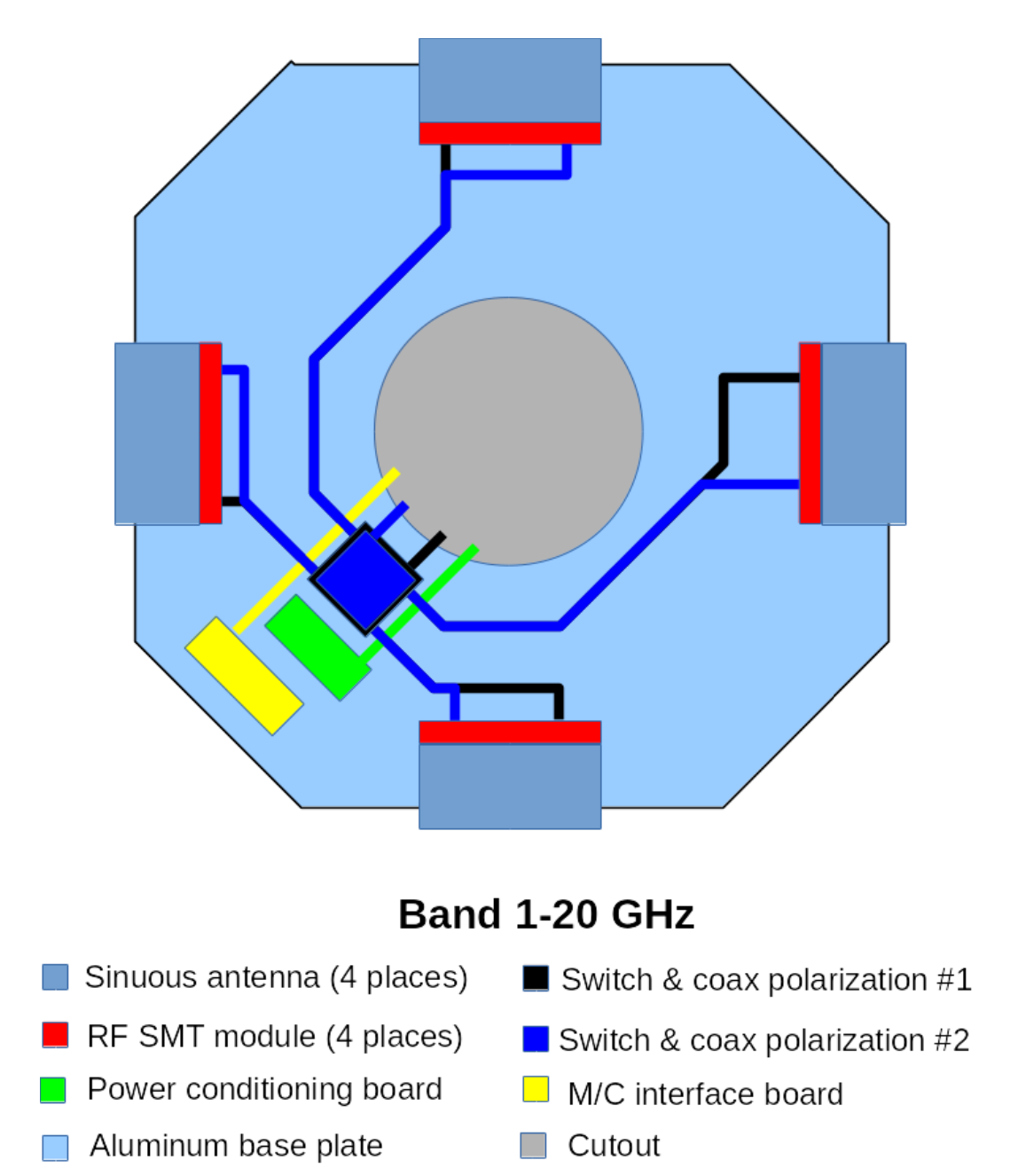
[click to enlarge]
Sketch of the ASM-2 1-20 GHz RF module showing the locations of the major components.
The NRAO National Radio Dynamic Zone (NRDZ) project is part of a national effort - supported by the National Science Foundation since 2020 - to define and establish an experimental zone for innovative and cooperative spectrum use. NRAO's work has involved the development and publication of spectrum-related educational materials, and the study of possible NRDZ conceptual designs based on input from a group of active and passive spectrum-use stakeholders.
Another essential part of NRAO's effort has been the design and construction of a spectrum monitoring device (Advanced Spectrum Monitor or ASM) that could be deployed in an eventual NRDZ. The initial design, development and construction work was led by engineers Kevin Shoemaker and David Bordenave (CDL). In May 2023, the "proof of concept" ASM-1 device (that covers 1-20 GHz) was deployed at Green Bank Observatory for initial field testing.
Lessons learned from these initial field tests have been critical to the redesign and development of a second generation device (ASM-2; that will cover 1-50 GHz). Design and testing of the ASM-2 device is underway, and the ASM-2 effort is being led by engineers Rich Bradley and David Bordenave (CDL). The ASM-2 device is designed to have improvements over ASM-1 in frequency coverage, sensitivity, direction finding and weather-proofing and is slated for on-site testing by Summer 2024.
NAASC Meeting recap: The Evolution of Gas in and around Galaxies
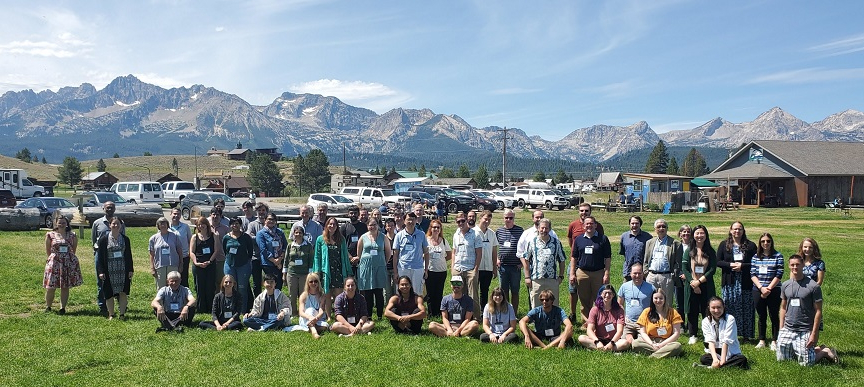
The NAASC-sponsored workshop entitled The Evolution of Gas in and around Galaxies was held in Stanley, Idaho from July 31 to August 4, 2023. The Scientific Organizing Committee (SOC), led by J. Donovan Meyer (NRAO), consisted of K. Devine (College of Idaho), N. Kanekar (NCRA-TIFR), J. van Gorkom and M. Putman (Columbia University), and R. Dave (University of Edinburgh).
Science topics focused on the evolution of the hydrogen content of galaxies and their surroundings, as these dictate the evolution of the eventual star formation activity of the Universe. The goals of the meeting were to compare and contrast the results of observations of HI 21cm, C+, and other tracers of the circumgalactic media surrounding galaxies, compare these observations with theoretical predictions, and to place the new results in the context of galaxy evolution. A further description of the scientific rationale and goals of the workshop can be found on the meeting website, as well as in the scientific program and abstract book.
Contact NRAO scientist Jennifer Donovan Meyer for information about this meeting.
VLA RFI Blanking
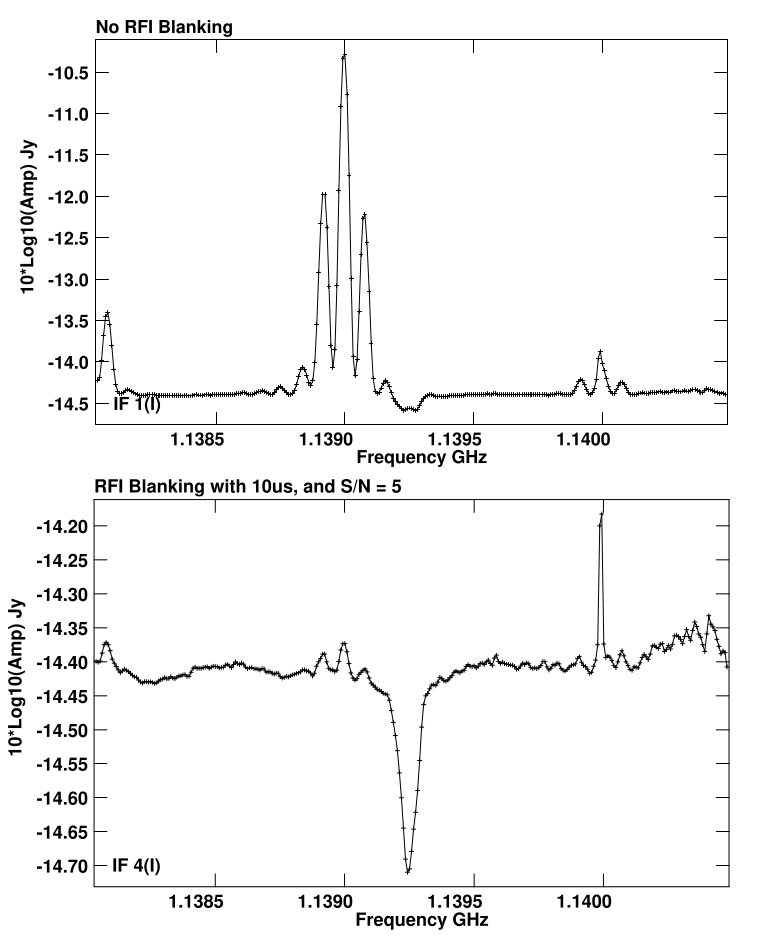
[click to enlarge]
Figure 1. Impact of real-time RFI blanking in WIDAR on the redshifted HI 21 cm absorption toward the quasar PKS1413+135. The top panel shows the spectrum without the application of the real-time RFI blanking, and the bottom panel shows the spectrum with the blanking applied.
We are pleased to announce the successful commissioning of a real-time capability in the VLA WIDAR correlator for the blanking of short-duration (~10 microsec), impulsive radio frequency interference (RFI). The mode partially mitigates interference from radars in L, S, and X Bands, in particular those used for aeronautical navigation between 1.0 to 1.2 GHz. This mode improves the data quality for approximately 15% of the L Band band-pass, and significantly improves the range of frequencies targeted by red-shifted HI 12 cm and OH 18 cm observations.
An example of the blanking applied to an astronomical signal is shown in Figure 1. Simultaneous, duplicate observations toward the z=0.247 quasar PK1413+135 without blanking (top panel) and with blanking (bottom panel) show the stark improvement in the fidelity of the red-shifted HI absorption spectrum before the application any RFI excision in post-processing. The blanking is not effective, however, at removing continuous sources of interference or interference that is intermittent but with high duty cycles (e.g., many digital and analog communication systems). Typical fractions of blanked data are less than 0.1% per integration even with significant RFI present.
Further details are in an IEEE Xplore article. The NRAO default VLA continuum resources from L to Ku Band will be updated to enable this feature, thus making it available for scheduling blocks prepared for the up-coming 23B semester. Alternative default continuum resources will be provided with this feature disabled. It will otherwise be disabled by default for custom resources but can be enabled through a toggle in the Resource Catalog Tool (RCT) of the VLA observation preparation software. A more detailed description will be provided to investigators in the email announcement for 23B scheduling block preparation.
SMA Call for Standard Observing Proposals - 2023B Semester

SAO/CfA/SMA
The Call for Standard Observing Proposals for observations with the Submillimeter Array (SMA) has been announced. This call is for the 2023B semester, with the observing period 16 Nov 2023 - 15 May 2024.
Proposal Submission deadline: Wednesday, September 20, 2023 20:00 UTC (16:00 EDT).
The SMA wishes to highlight important upgrades to the data reduction path, which now include the ability to convert raw or calibrated SMA data into MeasurementSet format for reduction and/or imaging within CASA. The full Call for Proposals, with details on time available and the proposal process is available now at the SMA Observer Center (SMAOC).
Details on the SMA capabilities and status along with proposal creation and submission is also done through the SMAOC.
SMA staff are happy to answer questions and provide assistance in proposal submission - simply email with any inquiries.
Arizona Radio Observatory 2023B Call for Proposals
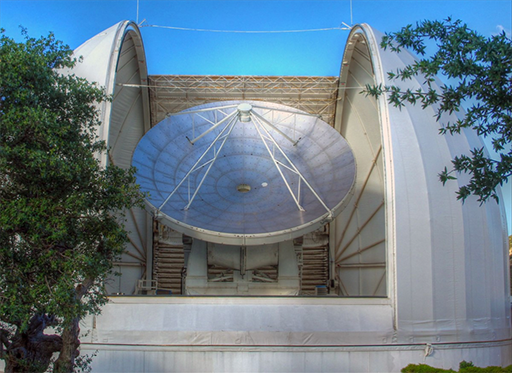
ARO
The Arizona Radio Observatory (ARO) solicits proposals for semester 23B (October 15, 2023 - Feb 15, 2024) for:
(1) The UArizona ARO Submillimeter Telescope (SMT), located on Mount Graham, Arizona. Proposals are invited from the general astronomical community.
(2) The UArizona 12-meter Telescope (12-m), located on Kitt Peak, Arizona. The KP 12M Telescope will host a PI instrument during part of semester 23B. At this time, proposals are invited from Arizona (UArizona, ASU, and NAU) affiliated observers only for the period of Oct 15 - Dec 1.
In case of oversubscription, preferential consideration will be given to Arizona (UArizona, ASU, and NAU) and student thesis proposals. Proposers are requested to fill out both pages of the cover sheet, science justification (two pages), technical justification (two pages), and past allocation update (one page).
View the ARO Call for Proposals for complete instructions. The deadline for proposals is 23:59 MST on September 20, 2023.
A Summer of Science: 2023 Student Programs
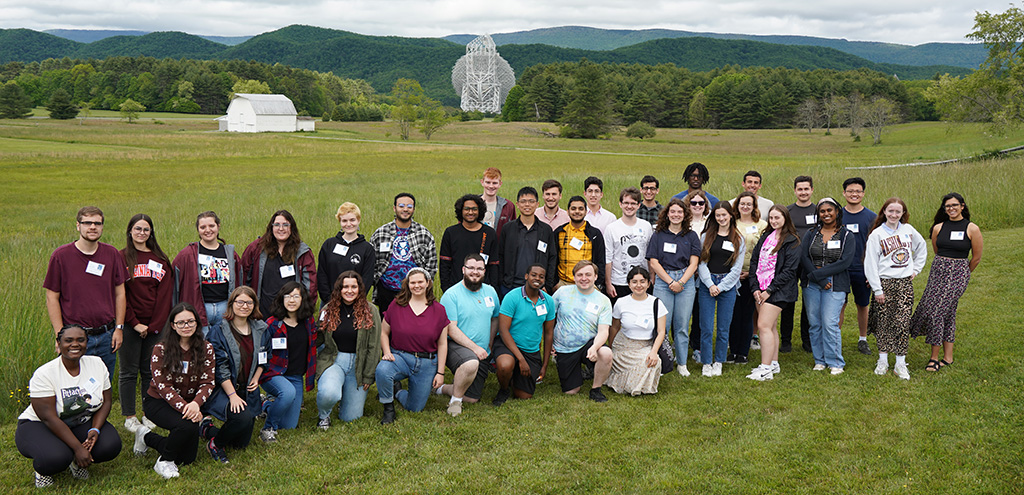
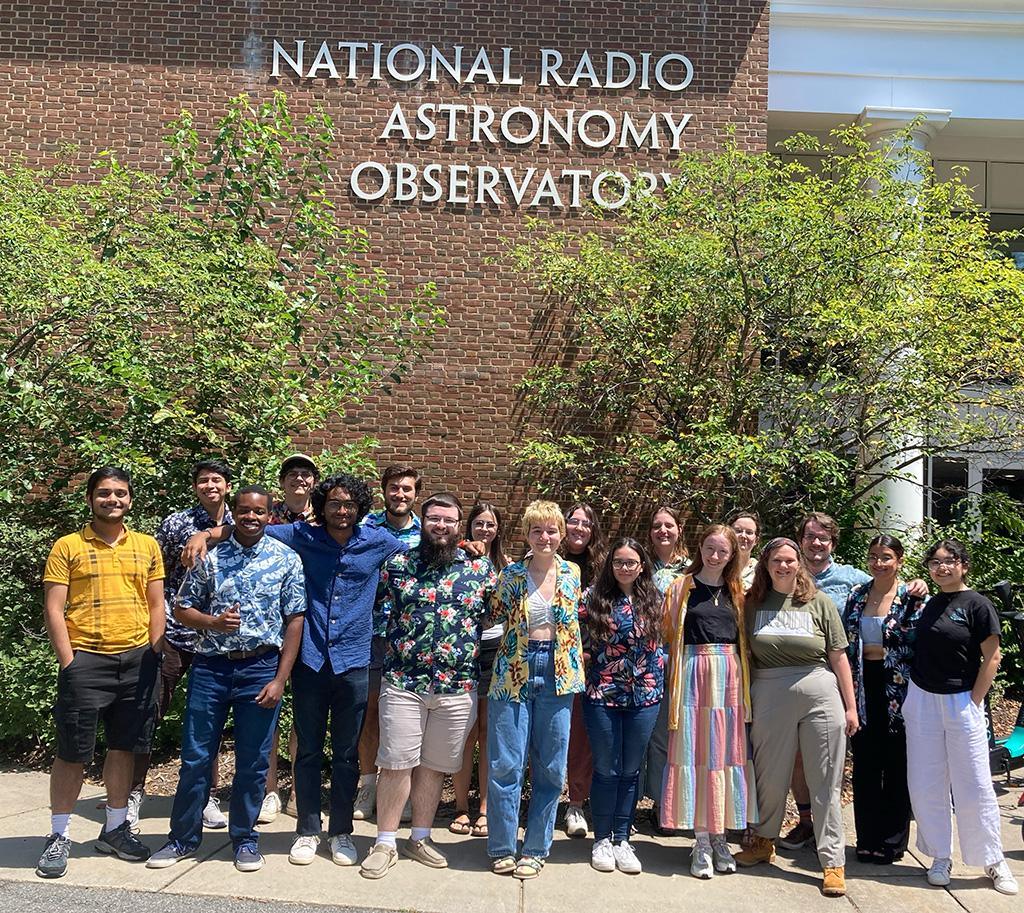
Jim Braatz (NRAO)
[click to enlarge]
2023 students at the NRAO Charlottesville Headquarters.
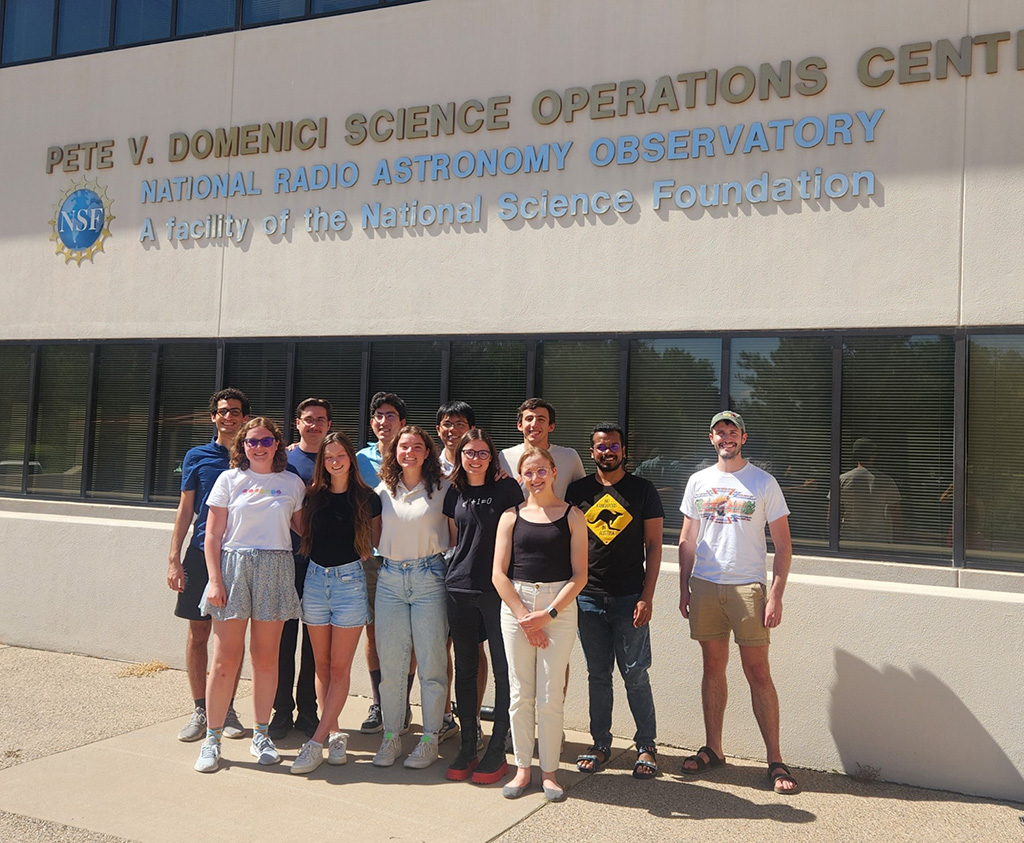
Anna Kapinska (NRAO)
[click to enlarge]
2023 students at the NRAO Socorro Science Operations Center.
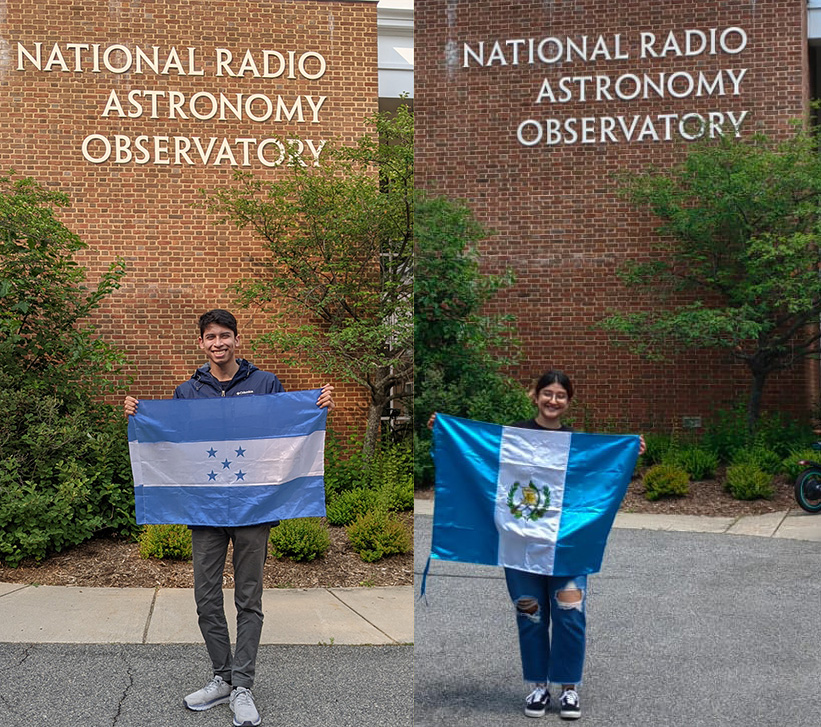
Anja Fourie (NRAO)
[click to enlarge]
2023 International NINE students worked on their program management and research projects - Daniel Argueta Vijil from Honduras and Gabriela Larios from Guatamala.
Galaxies. Pulsars. Exoplanets. Astrochemistry. RFI Mitigation. Electronics and Instrumentation. You name it - you'll find it in the research carried out by NRAO students during the summer of 2023. Students began their summer with a group bootcamp at the Green Bank Observatory before traveling to their respective homes for the summer to work one-on-one with their science and engineering mentors.
Students will be presenting their work at conferences like the AAS New Orleans meeting in January 2024. Stay tuned to our student program pages for announcements about future opportunities. Thanks to our students for all their hard work this summer in contributing to the mission of the NRAO and the long standing tradition of excellence in our student programs.
Photo from the Green Bank group bootcamp is shown above, courtesy of Jill Malusky.
Green Bank to be recognized as an APS Historic Site
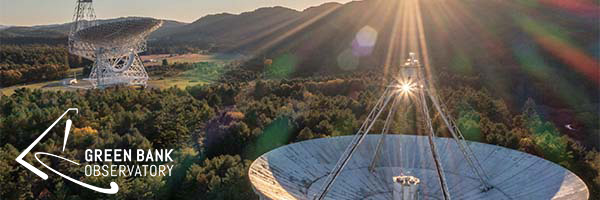
The Green Bank Observatory will be honored as an APS Historic Site, with a dedication ceremony on Wednesday, September 27, 2023. This honor is in recognition of historically significant scientific advancements for physics and contributions to the astrophysical sciences.
Green Bank Observatory has been a leading radio astronomy facility since its founding in 1957. Discoveries made here include the radio source at the center of the Milky Way, interstellar molecules, and the first pulsar in a supernova remnant, which confirmed the origin of these objects. It was also the site of the first systematic search for evidence of extraterrestrial civilizations.
Click here to learn more, or contact Jill Malusky for further information.
Spectrum Management Division welcomes Angel Vazquez

Angel Vazquez
[click to enlarge]
Angel Vazquez in the AO cable car riding up to the platform.
The Electromagnetic Spectrum Management Division is happy to welcome its newest employee, Angel Vazquez, who has joined NRAO as the Program Administrator for the Puerto Rico Coordination Zone (PRCZ). Angel worked for Arecibo Observatory for over 35 years, most recently serving as head of telescope operations, telescope scheduler and RFI/spectrum manager at the facility. Angel will work closely in the coming years with Zone Regulatory Services (ZRS) Coordinator Sheldon Wasik to safeguard the PRCZ radio environment.
Due to the collapse of the Arecibo Telescope - beginning on August 14, 2023 - the Arecibo site has transitioned to new site management and will be temporarily closed to the public. For the time being, at the request of the National Science Foundation, management of the Puerto Rico Coordination Zone (PRCZ) has transitioned to the NRAO. The Arecibo site will reopen to the public when on-site support is available, after a potential Arecibo Center for STEM Education and Research (ACSER) award and the associated start-up period. Angel will work remotely from his home in Puerto Rico.
Very Large Array Fall Open House
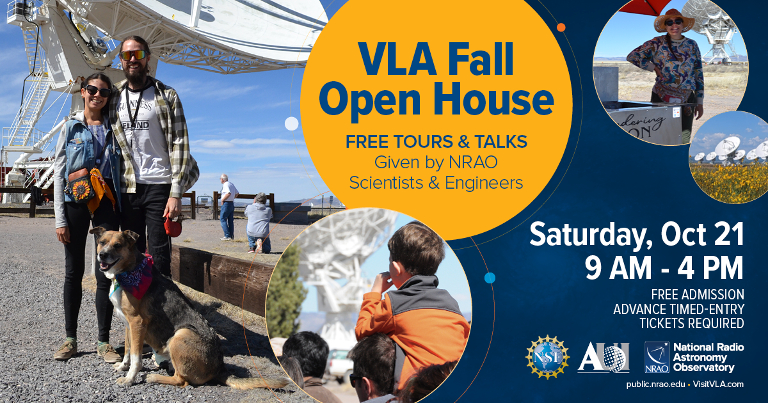
The Very Large Array Fall Open House will take place on Saturday, October 21, 2023, 9am to 4pm MT. Please see our website for details.
Recent Science Media Releases
|
VLBA Marks 30 Years Pushing the Bounds of Science |
|
|
VLA Finds Megastorms on Saturn Disrupt Gas Giant's Deep Atmosphere |
|
|
Contact the NRAO press office to share your new and exciting science results. |
From the Archives
Ellen Bouton

[click to enlarge]
About this month's photo: Thirty years ago, on August 20, 1993, Miller Goss, Tim Cornwell, Bob Brown, Peter Napier, Dave Shaffer, Dave Finley (at podium), and Dick Sramek take part in the dedication of the VLBA. The ceremony was held in the VLBA Operations area of the Array Operations Center in Socorro. The map behind Peter Napier contains LEDs indicating the locations of the VLBA antennas. The table to the left of the podium holds a bar code reader that was triggered by Senator Pete Domenici. When the bar code was read, azimuths and elevations began changing on the monitor behind Napier and, one by one, from East to West, the LEDs for the antennas lit up as they slewed toward their target, initiating observations of W3OH.
From the Archives is an ongoing series illustrating NRAO and U.S. radio astronomy history via images selected from our collections of individuals' and institutional papers. If readers have images they believe would be of interest to the Archives, please contact Ellen Bouton.

